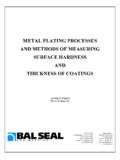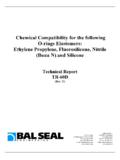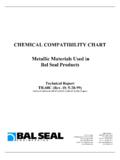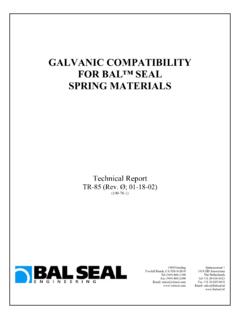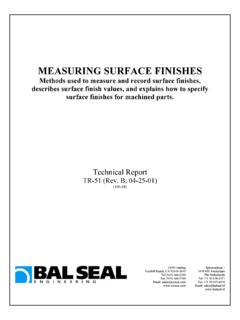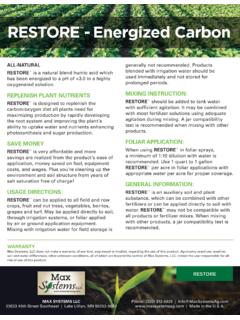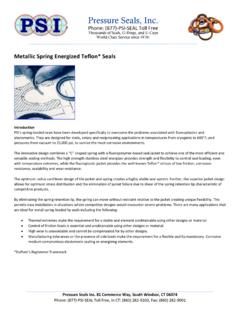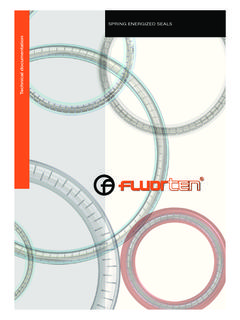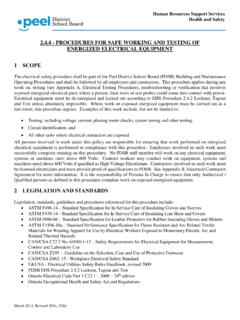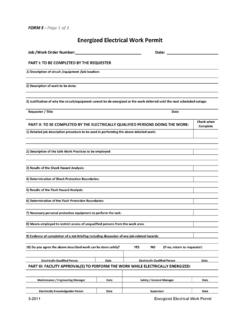Transcription of Electroless nickel plating: A general description of ...
1 Suite 901, Chinachem Century Tower178 Gloucester Road, Wanchai, Hong Kongt +852 28681860f +852 16, 5th floor1019 GW AmsterdamThe Netherlandst +31 20 638 6523f +31 20 625 PaulingFoothill Ranch, CA USA 92610-2610t +1 949 460 2100f +1 949 460 components that drive tomorrow s nickel plating : A general description of Electroless nickel plating and its effect on Bal Seal spring-energized seal performance in reciprocating and rotary serviceTechnical Report TR-16 (Rev. E; 7-27-15)(100-63-4)11of2 Electroless nickel plating : A general description of Electroless nickel plating and its effect on Bal Seal spring-energized seal performance in reciprocating and rotary serviceTechnical Report TR-16 (Rev. E; 7-27-15) (100-63-4)ContentsThe information, descriptions, recommendations and opinions set forth herein are offered solely for your consideration, inquiry, and verification and are not, in part or in whole, to be construed as constituting a warranty, expressed or implied, nor shall they form or be a part of the basis of any bargain with Bal Seal Engineering, If any sample or model was shown to or provided by Buyer/User, such sample or model was used merely to illustrate the general description and type of goods.
2 Such use is not to be construed as a warranty that the goods will conform to the sample or model. Furthermore, THE IMPLIED WARRANTY OF MERCHANTABILITY AND FITNESS FOR A PARTICULAR PURPOSE AND ALL OTHER WARRANTIES, IMPLIED OR EXPRESSED, ARE EXCLUDED AND SHALL NOT APPLY. This document provides product options for further investigation by Buyers/Users having technical expertise. The Buyer/User, through its own analysis and testing, is solely responsible for making the final selection of the products and for assuming that all performance, safety and warning requirements for the application are met. It is recommended that Buyers/Users run evaluation testing under actual service conditions to determine whether proposed Bal Seal Engineering products are suitable for the intended purpose. Nothing contained herein or in any of our literature shall be considered a license or recommendation for any use that may infringe patent rights.
3 (LE-17) PATENTS: The items described in this report include products that are the subject of the following issued United States patents: 5,979,904; 5,992,856; 6,050,572; 5,984,316; 6,161,838 and others, as well as foreign patents or products where patents are pending. (LE-88G) Copyright 2016 Bal Seal Engineering, Inc. Purpose of plating ..3 When to Use Electroless nickel 3 For Corrosion For Wear Resistance in Hard-to-Reach Areas ..4 Electroless nickel vs. Chrome plating vs. Boron Electroless nickel Coating: the Advantages and Disadvantages of Each Recommended plating Thickness ..4 Properties of Electroless nickel Variation in As Plated ..5 Heat Treated for One Hour at 750 F (400 C).
4 5 Corrosion Resistance and Surface Structure ..5 As Plated ..5 Upon Heat Friction Uniformity of plating Thickness and Deposition Rate ..5 Adhesion of plating and Material Being Dimension of Parts before and after plating ..6 Surface Finish before and after plating ..6 plating Thickness from to in. (from to mm)..6 plating Thickness > in. (> mm)..6 Electroless nickel plating Specifications ..6 Surface Cleaning and Activation Prior to plating ..7 Quality Control of Electroless nickel plating Effects of Contamination ..7 Control of plating Bath Conditions 7 Requirements after Stress Surface Finish after Properties of Boron Electroless nickel Variation in As Plated.
5 8 Heat Treated ..8 Corrosion Resistance and Surface Structure ..8 As Plated ..8 Upon Heat Friction Uniformity of plating Thickness and Deposition Rate ..9 Adhesion of plating and Material Being Dimensions of Parts before and after plating ..5 Surface Finish and plating ..9 Boron Electroless nickel plating Surface Cleaning and Activation Prior to plating ..9 Quality Control of Boron nickel Electroless plating Process ..10 Effects of Contamination ..10 Control of plating Bath Requirements after Stress Surface Finish after Sources of References ..1111of3 Electroless nickel plating : A general description of Electroless nickel plating and its effect on Bal Seal spring-energized seal performance in reciprocating and rotary serviceTechnical Report TR-16 (Rev.)
6 E; 7-27-15) (100-63-4) Summary This report outlines the process of Electroless nickel plating , including its advantages, disadvantages, limitations, and requirements in achieving a good quality plated surface. Electroless nickel plating is used in applications where corrosion resistance is desired and with plating intricate surfaces or small or deep bores. A uniform thickness with medium to high hardness can be achieved. The process is limited to certain types of metals and requires a strict, high level of quality control. Electroless nickel plating can greatly enhance Bal Seal spring-energized seal performance by lowering friction and increasing the hardness of the dynamic mating surface to reduce seal abrasion and extend seal Purpose of plating The purpose of Electroless nickel plating is to improve corrosion resistance, increase the surface hardness of the material, provide a uniform and dense coating, and in most cases, maintain the same surface finish the material had prior to plating .
7 Electroless nickel plating consists of the deposition of a nickel -phosphorous alloy onto the metal surface by a chemical bath, not by electrodes or external electrical charges. This method permits the plating of hard-to-reach surfaces, such as small or deep bores and intricate shapes. Coating thicknesses for engineering uses vary from to in. (from to mm) with hardness from approximately 48 to 52 Rockwell C. When the plating is heat treated at approximately 750 F (400 C) for one hour, the obtainable hardness varies from 58 to 64 Rockwell C. Boron Electroless nickel plating is another process that may be used. It produces higher hardness when required. The process allows for increasing the hardness from 60 to 62 HRC and from 70 to 72 HRC when heat treated. Electroless nickel plating provides a higher hardness, significantly improving Bal Seal spring-energized seal performance.
8 A harder surface greatly reduces the coefficient of friction and the adhesive force, resulting in lower wear and longer Bal Seal spring-energized seal When to use Electroless nickel plating Electroless nickel plating can be used in the as-deposited condition or may be hardened, depending on the intended service conditions. For Corrosion Resistance Because of its excellent corrosion resistance, nickel plating is used as deposited when the plated part is intended for a corrosive environment, such as brine, acids, etc. The plated part should not be hardened after coating, because hardening significantly reduces its corrosion nickel plating : A general description of Electroless nickel plating and its effect on Bal Seal spring-energized seal performance in reciprocating and rotary serviceTechnical Report TR-16 (Rev.)
9 E; 7-27-15) (100-63-4) For Wear Resistance in Hard-to-Reach Areas Electroless nickel plating is used when it is difficult or impossible to produce a uniform chrome plate using electrodes, such as in small or deep bores. The coating is hardened when increased wear resistance is desired for rotary or reciprocating service. Electroless nickel vs. Hard Chrome plating vs. Boron Electroless nickel Coating: the Advantages and Disadvantages of Each Method Recommended plating Thickness Generally, the most desirable plating thickness is from to in. (from to mm). Thicker plating could leave a wavy or rough surface that might require nickel plating High corrosion resistance in as-deposited condition Maintains better uniform thickness and surface finish Can plate small diameters, deep bores, and intricate shapes Requires high standards of quality control of surface preparation and plating solution Softer than chrome plating Some metal limitationsHard chrome plating Harder than Electroless nickel plating Relatively easy to plate Cost is similar to Electroless nickel plating , depending on parts Coarse surface finish after plating Small bores and intricate shapes are difficult to plateBoron Electroless nickel plating Can be placed on titanium.
10 Hardness is superior when compared with others Higher operating temperatures Requires no secondary machining Combines extreme hardness, corrosion resistance, ductility, and low coefficient of friction Cost-effective against hard chrome but is higher in cost when compared with Electroless nickel Can be plated on aluminum; undercoating is required11of5 Electroless nickel plating : A general description of Electroless nickel plating and its effect on Bal Seal spring-energized seal performance in reciprocating and rotary serviceTechnical Report TR-16 (Rev. E; 7-27-15) (100-63-4) Properties of Electroless nickel plating Electroless nickel plating has several properties that change when the plating is heat treated. It is important to select the proper plating condition to suit the application. Variation in Hardness As Plated From 48 HRC to 52 HRC Heat Treated for One Hour at 750 F (400 C) From 58 HRC to 64 HRC Corrosion Resistance and Surface Structure As PlatedThe surface structure is smooth, amorphous (non-crystalline), dense, non-porous, and continuous with excellent corrosion resistance.
